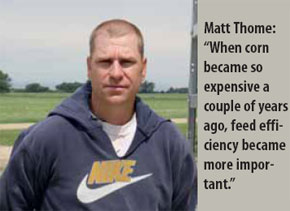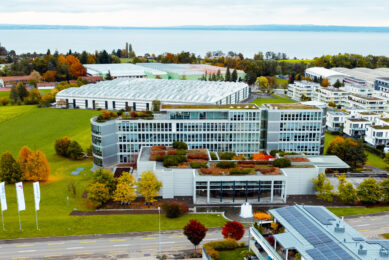Soaring feed prices lead to more efficient use

At Thome Family Farms, located near Adams, Minnesota, USA, a tailor-made solution has been found in many aspects of the swine finishing operations. Ever since feed prices have been soaring in the USA, now more than ever precision feeding is the way forward.
By Vincent ter Beek
Minnesota, in the mid-west of the USA, is known for different things. Where the state’s north is known for its beautiful woods and lakes, the south consists of fertile arable fields that stretch beyond the horizon. It’s ideal for crop farming, wind energy production – and swine production.
Together with his father Gary and brother Pat, Matt Thome owns Thome Family Farms, a farrow-to-finish farm, located near the town of Adams, MN. They use their 1,500 acre (607 ha) fields for the cultivation of soybeans and corn. Feed and manure are used very sustainably. The revenue of his crops is eaten by the pigs; the pigs’ manure will go on the fields again.
Pat and Matt together take care of the nursery and the finishing section; the breeding stage, in which PIC genetics are used, is operated by a different party. In the finisher section, pigs come in at about 35 pounds (16 kg) and are sold to Hormel meatpackers in nearby Austin, MN, at 270 pounds liveweight (122 kg). Spread out over the fields, the Thome family had four almost identical brand new finishing houses built over the last couple of years. Each of these four finishing houses has dimensions of 122 x 164 feet (37 x 50 m), and all have a capacity for 2,400 finishers; they are designed according to the principle of ‘double wide tunnel ventilation’ – it has two long parallel rooms. One is used for barrows and one for gilts, as the Thome family acknowledge their differences in growth pattern – gilts growing more consistently, and barrows having a rapid growth curve towards the end of finishing.
Silos
Matt Thome explains he appreciates a tailor-made approach in the swine farm’s feed approach for many reasons. “Ten years ago, the main purpose of corn in the USA was for use in livestock feed. Nowadays corn is also used for ethanol which caused prices to soar. As pork producers, we are always driven by feed costs. So when corn became so expensive a couple of years ago, feed efficiency became more important.” It’s the feeding system used in two of the four barns that make the difference. Two pig houses have been equipped with a conventional feeding system and two with a differentiated feeding system, allowing for precision feeding to specific groups of pigs that require extra feeding efforts. “In these two pig houses, we don’t have to feed average amounts to the animals,” Thome says.
Where differentiated feeding was installed, the Thome family had the pig houses equipped with two types of silos (See photo 1); the group of silos to the right containing high energy, high protein feed; the three to the left contain low energy, low protein feed.
Average pig weight is a tool that is crucial in managing the system. A sorting sluice in each room constantly weighs the animals and helps to obtain the average weight of the pigs in every pig house. Depending on animals being below or above average weight, they are directed towards the section providing mainly ‘high energy, high protein’ feed, or mainly ‘low energy, low protein’ feed. Since the whole pen is a one-way circuit, pigs can walk around and again quickly end up at the sorting sluice.Key to keep this system going is the presence of this ‘FeedSaver’, an on-farm feed mixing instrument developed by Feedlogic (See photo 2). It links to the two different groups of feed silos outside and can mix the feed in any right proportion desired to fill the 21 feeders per pig room.
Early in finishing, rations will contain more high energy, high protein feed than at later stages (moving from 90-10% to 10-90%); and the section for the smaller pigs will get fed more high energy, high protein feed as well. Two tubes are used, as is shown in photo 3, for the two different feed rations – one linking to the section for the smaller pigs in the front; one directly linking to the faster growers in the back.
Thome provides his feed ad-lib and in solid form, but it can be mixed with water at will by the pigs by nudging a valve. The animals also have a separate drinking trough at their disposal. At the finisher section, the pigs reach an average daily gain of 2.7 pounds, which is about 1.22 kg. Thome can compare results with ordinary, non-sophisticated feeding methods and he says he can tell the difference.
| Feed saving technologies Feedlogic, headquartered in Wilmar, Minnesota, is a producer of dynamic nutrition management systems. It promotes the so-called ‘feeding on a curve’ principle. In short, this principle is based around the idea of blending two types of base diets in order to match pigs’ requirements at each stage of the growth. This can be monitored or adjusted by the use of a computer programme. The idea is being promoted in a static version, as has been shown in the Thome farm (S-Series) and there is also a mobile version (M-Series), in which a robot fixed to a rail moves the feed to certain pens. |
Meticulous approach
Apart from having a specific feed approach, Thome Family Farms also appreciates efficient use of energy and ventilation as well. For this reason, much software regulates mechanisms on-farm, like the constant measuring and adjusting of pig house temperature and ventilation. On average, Thome comes in and checks the pig houses three times a day, but the computer systems will alert him whenever there is a problem.
As indicated, tailor-made ventilation is considered important in a region where the climate can sometimes be extreme – heavy rains, heavy winds, high average temperatures as high as 85˚F or 29˚C in summer or as low as 20˚F or -7˚C with excessive snow and cold wind. An internal ventilation system will regulate indoor temperature, while curtains are drawn in winter time. In summer, the ventilation is regulated through tube ventilation, which generates a steady and pleasant flow throughout the day.
Thome says he is convinced his hogs do best when they feel well. Therefore he keeps them on 8 ft2 (0.75 m2) per pig, which is above average in the US. He also allows the pigs to walk around freely. The result of this? The animals appear calm and not stressed – See photo 4. PP
For more pictures of this farm, please visit: www.pigprogress.net/photo-gallery/farm-visits











